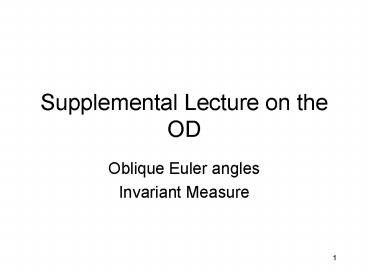Supplemental Lecture on the OD PowerPoint PPT Presentation
1 / 19
Title: Supplemental Lecture on the OD
1
Supplemental Lecture on the OD
- Oblique Euler angles
- Invariant Measure
2
Need for Oblique Euler angles?
- In addition to the distortion of the Euler space
from plotting in a Cartesian frame, there is a
singularity near the origin. - When the second angle is zero, the first and
third angles are not independent because their
rotation axes are coincident. - This leads to the idea of using sum and
difference angles.
3
References
- Bunge (1988). Calculation and representation of
the complete ODF. ICOTOM-8, Santa Fe, TMS,
Warrendale, PA. - Helming et al. Helming, K., S. Matthies, et al.
(1988). ODF representation by means of sigma
sections. ICOTOM-8, Santa Fe, TMS, Warrendale, PA.
4
Definitions
- Kocks n (Y-f)/2 µ (Yf)/2
- Bunge (f,f-)
- Helming (s,d)
- Convert f s np/2, f- dp/2 µ
5
Advantage of Oblique angles?
- Textures close to the origin are not distorted,
or smeared out over lines in the Euler space. - Useful for textures with the cube component,
001lt100gt. - Also useful to combine two standard Euler angles
with one oblique angle. - Example rolled recrystallized Cu, Kocks, Ch.
2, fig. 30.
6
Example of Rolled and Partially Recrystallized
Copper
- Work of Carl Necker (Los Alamos) on
recrystallization texture and kinetics in copper,
PhD thesis, Drexel Univ. 1997. - Sample exhibits weak remanent rolling texture
with strong cube texture. - Cube texture is present in all sections of Euler
space, especially along the edge with F0. - popLA analysis
7
(No Transcript)
8
9102.cmh
Note the smearingout of the cubecomponent on
theupper edge of thesections. 5 smoothing
9
9102.cmh
Labels should be forn at 2.5 intervals. Note
that cube component is confined to corners at 0
and 45, or along top edge.
10
Use of Oblique Angles
- Use oblique angles whenever you encounter
textures with strong components near F0. - Also useful when plotting in polar coordinates
(as opposed to Cartesian).
11
Topic no. 2 invariant measure
- In Euler space, as previously stated, the
invariant measure is dg sinFdFdf1df2 - With a different choice of variables, a different
invariant measure obtains.
12
Axis-angle representation
Axis is written either as aunit vector (3
components,not independent) or as twoangles,
with an angle. g g(n,w) g( ,q) Figure
illustrates the effect of a rotation about an
arbitrary axis, OQ (equivalent to and n)
through an angle a (equivalent to q and w).
13
Invariant Measure
- Invariant measure preserves volume element
constancy. - In Cartesian coordinates, the volume element is
dV dr1dr2dr3, so I(r1r2r3)1. - If we transform to spherical coordinates, dV
r2sinqdqdrdy, so I(qry)r2sinq - Contrast with invariant measure for rotations
in Euler space, dg sinFdFdf1df2 , so I(F,f1,f2)
sinF
14
Invariant Measure, contd.
- If we use a rotation angle, w, and two angles to
specify the axis, (q, y), we obtain dg 1/p2
sin2(w/2) sinqdqdwdy - How to convert from one set of parameters to
another?
15
Use of Jacobian
- Construct the Jacobian for the transformation
between the two sets of parameters. - The factor that relates a volume element in one
system to that in another is then Ia,b,c
J Ia,b,c
16
Axis-Angle to Axis-radius
- Set q q, y y, r tan(w/2).
- dq dq, dy dy, dr dtan(w/2), dw
2dr/(1r2). - J 1/2 (cos2(w/2))
- I(q,y,r) I (q,y, w) / J
- I(q,y,r) 1/p2 sin2(w/2) sinq 2cos2(w/2)
17
Axis-Angle to Axis-radius, contd.
- I(q,y,r) 1/p2 sin2(w/2) sinq 2cos2(w/2)
2/p2 sinq tan2(w/2) cos2(w/2)2 2/p2 sinq r2
/(1r2)2 Since 1/cos2x 1tan2x.
18
Axis-radius to Cartesian-radius
- To pass from axis-radius to axis-cartesian, apply
the relationship J r2 sinq . - I(r1r2r3) I(q,y,r) / J 2/p sinq r2
/(1r2)2 / r2 sinq 2/p 1 /(1r2)2
19
Cartesian-radius to Cartesian-solid angle
- Solid angle W A/r2 ? d W dA/r2.
- dA r2 sinqdqdy
- Thus dg 2/p 1/(1r2)2 r2 sinqdqdydw 2/p
1/(1r2)2 r2 dW dr
dA
dA

